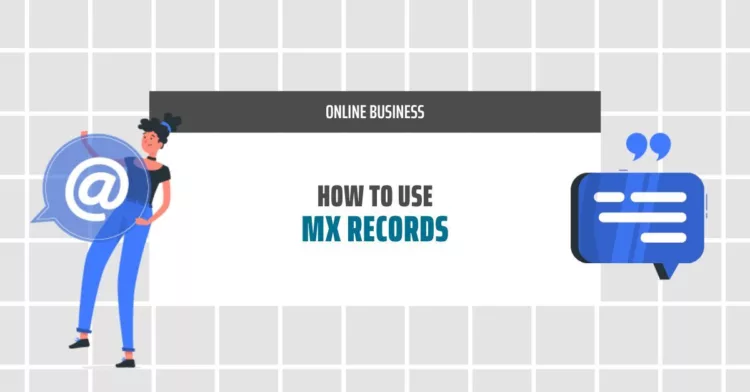What are MX Records and how to use them in 2024

This article explores MX Records, which are crucial for directing emails to the correct mail server using SMTP. We review their functions, benefits like load balancing and enhanced security, and provide a detailed guide for setting up MX records, including login, DNS navigation, and configuring hostnames, TTL, and mail servers.
Have you ever wondered why your emails, like well-trained digital carrier pigeons, know where to go?
The secret lies in MX Records.
These powerful settings dictate the flow of your emails. They ensure your emails reach their intended destination rather than get lost in the digital ether.
But what are MX Records exactly?
This guide will answer the question of “What are MX records?” and provide practical insights and easy instructions for using MX Records.
What is an MX record?
An MX or Mail Exchange record directs emails to the correct mail server using the Simple Mail Transfer Protocol (SMTP).
Think of an MX record as a digital traffic controller, pointing each email to its destination server.
When someone sends an email to you, their email service queries the DNS for your domain's MX record to find out where to deliver it.
This record specifies the mail server which accepts email messages on behalf of your domain.
Without an MX record, your emails might as well be shouting into the void – they wouldn't know where to go.
Step-by-step instructions to set up MX records
Are you looking to establish a new mail server or update existing MX records?
These clear and concise instructions will guide you through each phase of the process.
1. Login to your domain host
The first step in setting up your MX records is to log in to your domain host.
Your domain host is where your website's domain name is registered. It's the key place for managing the settings related to your domain.
If you need to find out who your domain host is, check where you registered your domain name or look up your domain's WHOIS information.
Once you've identified your host, use your credentials to log in to your account.
2. Navigate to DNS records
Once logged into your domain host, the next step is finding your way to the DNS records section.
This is typically located under a menu labelled 'DNS Management', 'Name Server Management', 'Control Panel', or something similar.
Here, you'll encounter various records - A, CNAME, TXT, and, notably, MX records.
The MX record section is your target. It's essential to proceed with caution and attention to detail.
Warning: A small mistake in DNS settings can lead to big problems, such as your website becoming unreachable or emails not being delivered. If you need more clarification, it's always a good idea to consult your host's support documentation or contact their support team for guidance.
3. Delete existing MX records
Before you can set up new MX records, clearing the slate by removing any existing ones is crucial.
This step is essential to prevent conflicts that could disrupt your email service.
Look for entries labelled as 'MX' in the DNS records section. These represent your current MX records.
Carefully review them to ensure you're not deleting something important, especially if you update records for an existing domain with active email services.
If you're uncertain about a record, make a note of it or take a screenshot before deletion for future reference.
To delete a record, you'll typically find a delete or remove option next to the record.
Click this and confirm the deletion.
This process will clear the way for adding new MX records that point to your preferred mail server.
4. Create a new record
With the old MX records out of the way, it's time to create a new one. This is where you define the path your emails will follow.
In the DNS records section, look for an option to 'Add Record' or 'Create New Record'.
Select 'MX' from the list of record types. Now, you'll enter the details for your new DNS MX record.
This includes specifying the mail server address (hostname), the priority, and time-to-live (TTL).
5. Specify the host name
Once you've added the new MX record, the next critical step is specifying the hostname.
The hostname sometimes called the 'domain' or 'name' in the record settings, determines which domain the MX record applies to.
You'll usually enter your primary domain name here, such as 'yourdomain.com'.
If you manage multiple subdomains and each has its mail server, you must specify the appropriate subdomain as the hostname for each MX record.
It's essential to enter the hostname accurately to avoid any misrouting of emails. A typo here could mean emails intended for your domain getting lost in cyberspace.
Double-check this entry for accuracy before moving on to the next step in configuring your MX records.
6. Specify the TTL
The final step in setting up your MX record is specifying the TTL or Time to Live.
TTL is a crucial yet often misunderstood element of DNS records.
It determines how long a server should use the information on your MX record before checking back for updates. The TTL is measured in seconds, and your chosen value can have significant implications.
A lower TTL, such as 300 seconds (5 minutes), means changes to your MX record propagate faster across the internet, but it can also increase the load on your DNS server due to more frequent checks.
A higher TTL, like 86400 seconds (24 hours), reduces the frequency of updates, offering more stability but slower propagation of changes.
A middle-ground TTL (around 3600 seconds or one hour) is a practical choice for most users. It balances timely updates with server load, ensuring your mail exchange records are refreshed at reasonable intervals.
7. Specify the mail servers
After setting the TTL, the final MX record configuration specifies the mail servers.
Here, you direct your domain's email traffic. You need to enter the mail server's address to handle your emails. Typically, your email hosting provider provides this. It might look like 'smtp.yourdomain.com' or 'mail.yourdomain.com'.
If you have more than one mail server for backup or load balancing, you'll add each one here, along with its respective priority.
8. Specify the priority
Along with specifying your mail servers, setting the correct priority for each MX record is critical.
The priority, sometimes called 'preference', determines the server utilisation order.
It's a numerical value, where a lower number indicates higher priority.
For instance, you don't want to assign the same priority if you have multiple mail servers, like a primary mail server and a backup. In this scenario, you could assign a priority of 10 to the primary mail exchange server and 20 to the backup.
This means the email system will attempt to deliver emails to your primary server first. It will try the server with the next highest priority if it is unavailable.
Double-check these numbers for accuracy. A simple mix-up here can lead to unintended email routing.

Why must you know how to use MX records?
Knowing how to use MX records improves the management of your email communication.
Here are some practical benefits of using MX records:
1. Directing email traffic:
Understanding MX records and how to configure them allows you to control where your incoming emails are directed. You can specify which mail server should handle your emails. This is particularly useful if you have many email servers for different purposes.
2. Load balancing and redundancy:
Configuring multiple MX records allows you to create a load balancing and redundancy system for your email services. If one mail server is down, another can take over, ensuring continuous email flow. This means your communication remains uninterrupted, a crucial factor for business operations.
3. Enhanced security and spam control:
Sophisticated MX records setup can help filter spam and improve email security. You can reduce the risk of security breaches and unwanted spam by directing your emails through servers with robust security and spam filtering capabilities,
4. Customised email routing:
MX records allow you to route emails based on specific criteria. For instance, you can route emails to different servers based on their geographical location or the nature of the email content.
5. Improved email delivery rates:
Properly configured MX records help improve your mail delivery rates. When other mail servers see that your MX records are set up, it increases the trustworthiness of your domain. This reduces the chances of your emails being marked as spam.
Mastering MX records allows you to streamline your email communication, enhance security, and ensure reliability and efficiency in your email system.

Key considerations for successfully using MX records
Successfully managing MX records goes beyond just setting them up. It requires thoughtful consideration to ensure they are used to their fullest potential.
Here are some nuanced, actionable tips to help you master the art of MX record management:
Regularly update and review:
MX records aren't a 'set it and forget it' aspect of your domain. Regularly review and update them. This is especially true if you change email hosting providers or reconfigure your mail servers.
Use a reliable secondary mail server:
Having a backup mail server is about redundancy and reliability. Choose a secondary server that is as reliable as your primary to ensure seamless email delivery, even during server downtimes.
Monitor email delivery metrics:
Monitor your email delivery success rates. If you notice a high rate of bounced or undelivered emails, it may be a sign to review your MX record configuration.
Understand SPF and DKIM records:
While not directly related to MX records, SPF (Sender Policy Framework) and DKIM (DomainKeys Identified Mail) records play a significant role in email security and deliverability. Ensure these records are set up to enhance the credibility of your emails.
Test after changes:
Whenever you change your MX records, conduct tests by sending emails to and from various external domains. This ensures your configuration is working as intended.
Seek expert advice for complex setups:
Consider consulting with an IT expert if your email setup involves multiple domains or mail servers. They can help you navigate the intricacies of MX records and ensure optimal configuration.
Plan for disaster recovery:
Have a disaster recovery plan that includes your email infrastructure. This means knowing how to quickly restore your MX records in case of a major issue, like a domain transfer or hosting provider outage.
Keep documentation:
Document your MX record configurations and any changes you make. This historical record can be invaluable for troubleshooting and for new team members to understand your email infrastructure.
Final thoughts
Navigating MX records requires precision, foresight, and a keen understanding of how these records impact your email communications.
However, managing MX records doesn't have to be a complicated task.
EuroDNS gives you access to a user-friendly platform that simplifies Domain Name System Management. We turn a complex process into a straightforward, manageable one.
Whether you're a seasoned IT professional or just starting, EuroDNS offers the tools and support to ensure your email systems are robust and reliable.
So, take the next step in optimising your email infrastructure!
Visit EuroDNS today and discover how our DNS management services can elevate your email communication.
FAQ
What is a MX record example?
An example of an MX record would be something like “eurodns.com | MX | 3600 | 10 aspmx.l.eurosdns.com.” where “10” is the priority of the mail server, and “aspmx.l.eurodns.com.” is the address of the server responsible for handling emails for your domain.
Host Name | Type | TTL | Data |
eurodns.com | MX | 3600 | 10 aspmx.l.eurodns.com. 15 alt1.aspmx.l.eurodns.com. 20 alt2.aspmx.l.eurodns.com. 25 alt3.aspmx.l.eurodns.com. 30 alt4.aspmx.l.eurodns.com. |
What MX records should I have?
The MX records typically include the address of your primary mail server and, optionally, backup servers with their respective priorities. Always ensure these records are accurate and reflect your current email server configurations for efficient delivery.
How do I know if my MX record is valid?
To check if your MX record is valid, use an online MX record lookup tool to verify if the record exists and is pointing to a valid mail server. Additionally, ensure no email delivery issues, as these can indicate problems with your MX record configuration.
Author Bio
Julian Lankstead is the founder of JulianLankstead.com. He helps businesses increase revenue by providing strategies to improve business process efficiency.
Price change for .me and .net from 1st February 2024
Related articles:
